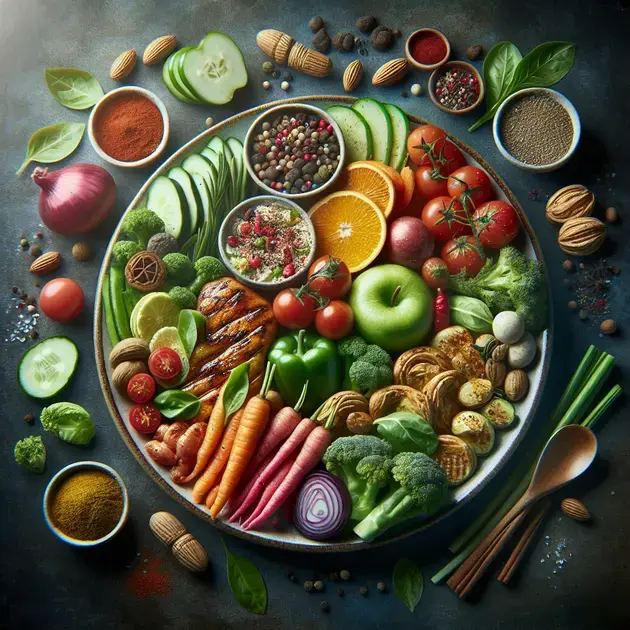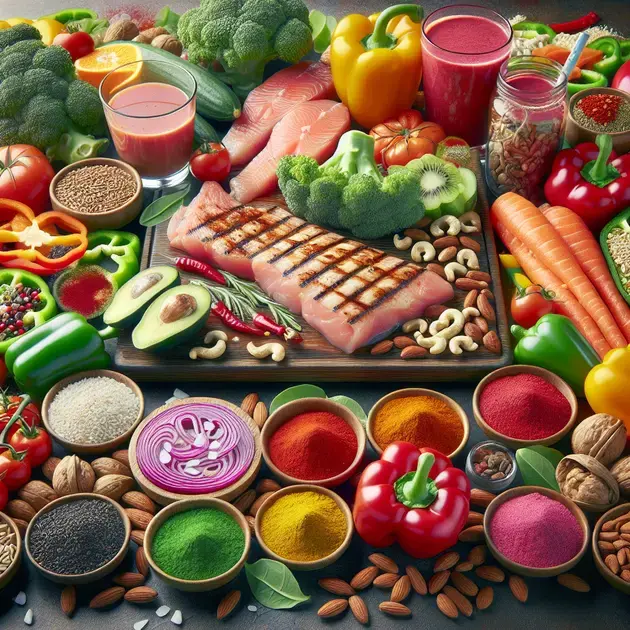Are you tired of balancing your diet without seeing the results you desire? Understanding which metabolism-boosting foods actually work can be the game changer you need. In this article, we’ll explore the science behind these foods and how incorporating them into your meals can supercharge your metabolic rate and energy levels.
From protein-packed options to spicy ingredients that fire up your digestion, we’ll dive into the top choices that can help you burn calories more efficiently. Say goodbye to dietary guesswork and hello to a more effective way to manage your weight and health!

Understanding Metabolism and Its Role in Weight Loss
Metabolism refers to the complex set of chemical reactions that occur in your body to convert food into energy. This process is crucial for maintaining life, as it helps your body perform essential functions, such as repairing tissues and regulating temperature. For weight loss, understanding metabolism is key. A higher metabolism means your body burns more calories at rest.
There are two main components of metabolism: basal metabolic rate (BMR) and total daily energy expenditure (TDEE). BMR measures the number of calories your body needs to perform basic life-sustaining functions. TDEE considers your BMR along with your activity levels, assessing how many calories you burn throughout the day.
To stimulate your metabolism, consider incorporating strength training exercises. Strength training not only helps build muscle mass, which naturally burns more calories, but it can elevate your metabolism for hours after your workout. You can find a variety of strength training guides on fitness apps like MyFitnessPal, which can recommend workouts tailored to your fitness level.
Another factor is age; as you age, your metabolism tends to slow down. However, this doesn’t mean you can’t take steps to boost it. Engaging in regular physical activity and ensuring adequate protein intake can significantly enhance your metabolic rate, even as you age. Tracking these activities can be simplified using fitness apps.
Ultimately, understanding your metabolism allows you to make informed dietary choices and tailor your exercise routines for effective weight loss. Resources such as health and nutrition websites provide insights into how metabolism works, guiding you to develop a plan that works for you.
Top Foods That Naturally Boost Your Metabolism
Certain foods can naturally enhance your metabolism and, thereby, help with weight loss. One of the best groups of foods for this purpose is protein-rich items. Foods like lean meat, eggs, and fish require more energy to digest, meaning you’ll burn more calories processing them. Meal tracking apps like Cronometer can help you analyze your protein intake effectively.
Spices, especially those that contain capsaicin, such as chili peppers, can also temporarily boost metabolism. Adding these to your meals not only enhances flavor but can also accelerate calorie burning. Consider using culinary apps for recipe ideas featuring these spicy ingredients to make your meals both delicious and metabolism-friendly.
Green tea and coffee are excellent beverages that provide metabolism-boosting effects. Both drinks contain caffeine, which can enhance metabolic rate and increase fat oxidation. You can explore various coffee recipes on platforms like Pinterest to find enjoyable ways to incorporate these drinks into your routine.
Whole grains like oats and quinoa are not only nutrient-dense but also provide sustained energy, which helps keep your metabolism running efficiently. You can find meal prep ideas for whole grains on meal planning apps, which will assist you in incorporating these metabolism-boosting foods into your diet.
Finally, incorporating healthy fats, such as those found in avocado and nuts, can also play a role in weight management. These foods take longer to digest, promoting a feeling of fullness and aiding in calorie control. Use grocery list apps to keep track of these foods for your shopping to ensure you’re stocked with metabolism-friendly options.
How to Incorporate Metabolism Boosting Foods into Your Diet
Incorporating metabolism-boosting foods into your diet involves planning and preparation. Start by educating yourself about which foods are beneficial. Use nutrition tracking tools like Lose It! to discover calories and nutrient content for various foods, helping you make informed choices.
Begin by ensuring that you have a variety of metabolism-boosting foods on hand, such as fruits, vegetables, lean proteins, whole grains, and healthy fats. Create a grocery list focusing on these items, and use grocery apps to organize your shopping. Shopping from a list minimizes impulse buys and ensures you get everything you need.
Next, meal prep can be incredibly helpful for keeping healthy foods readily available. Dedicate one day a week to cook and portion out meals with these nutrient-rich ingredients. You can find meal prep tutorials on YouTube that break down the process, making it easier to follow along.
Incorporate salads or oatmeal into your breakfast and lunch; these are excellent meals that can easily include many of the aforementioned foods. There are plenty of recipe websites, such as AllRecipes, where you can get inspiration to make these meals delicious and engaging.
Finally, keep track of how these dietary changes affect your energy levels and cravings. Periodically review your progress using food logging apps. This reflection allows you to adapt and tweak your diet, ensuring it remains enjoyable and effective for boosting your metabolism.

Understanding Metabolism Boosting Foods
Metabolism boosting foods are those that can help enhance your metabolic rate, leading to improved energy expenditure and potentially aiding in weight management. These foods play a crucial role in how our bodies convert the energy we consume through food into energy we can use. When we consume metabolism boosting foods, our bodies burn calories more efficiently, which can help in shedding excess weight. Understanding how these foods work can significantly impact your overall health and wellness.
Foods that are known to increase metabolism often have specific properties that elevate bodily functions. For instance, some foods require more energy to digest, which increases calorie burn. Also, certain nutrients can stimulate the production of hormones that regulate metabolism. It’s important to integrate these foods into your diet for optimal results.
Common examples of metabolism boosting foods include high-protein items like lean meats and legumes. Protein takes longer to digest than carbohydrates or fats, leading to a phenomenon called the thermic effect of food (TEF). This means that your body actually burns more calories processing protein. Other notable items include spicy foods, such as chili peppers, which contain capsaicin that can temporarily increase your metabolic rate.
Incorporating metabolism boosting foods can be simple. You can add some of these items into breakfast, lunch, or dinner. For instance, starting your day with a protein-rich smoothie or having a salad topped with lean chicken can significantly boost your metabolism. Additionally, considering quantity and combinations of these foods can create a more impactful dietary approach.
Understanding and utilizing metabolism boosting foods not only aid in weight management but also promote overall health. These foods can improve muscle retention, energy levels, and even mood. Therefore, it is beneficial to include a variety of these foods in your diet to maximize your body’s metabolic potential.
Top Metabolism Boosting Foods to Include in Your Diet
When it comes to metabolism boosting foods, there is a wide array of options that can fit into any diet. Starting with proteins, foods like chicken, turkey, and fish are excellent choices. These proteins not only support muscle growth but also help maintain muscle mass, which is important for keeping metabolism rates high. Lean meats, if prepared in a healthy way, can be delicious and beneficial for your metabolism.
Another category of metabolism boosting foods includes nuts and seeds. Almonds, walnuts, and flaxseeds are not only packed with healthy fats but also provide protein and fiber that can keep you feeling satiated while encouraging your body’s metabolism to function optimally. Including a handful of nuts in your daily diet can be an easy and nutritious way to enhance your metabolism.
Fruits and vegetables also play an important role in this category. Spinach, kale, and broccoli are high in fiber and low in calories, often leading to a higher thermic effect as your body works to digest them. Similarly, fruits such as berries, grapefruits, and apples can contribute to a healthy metabolism, providing essential vitamins and antioxidants that support bodily functions.
For those who enjoy spices, including ginger and turmeric can be beneficial. These spices not only enhance flavor but also have properties that can stimulate metabolic processes. Utilizing these in your cooking can be a flavorful way to improve your metabolic health. For example, adding ginger to smoothies or curries can give you that metabolism boost.
Herbs like green tea and coffee also belong on the list of metabolism boosting foods. Both beverages have been shown to enhance calorie burning due to their caffeine content. Drinking a cup of green tea or a black coffee in moderation can serve as an excellent stimulant for your metabolism. You can enjoy these drinks in various forms, whether hot or iced, making them a versatile addition to your daily routine.
How to Prepare Your Metabolism Boosting Meals
Combining Metabolism Boosting Foods for Maximum Effect
Exercise and Its Role with Metabolism Boosting Foods
Conclusion
Understanding metabolism is crucial for anyone looking to lose weight effectively and sustainably. It involves the body’s ability to convert food into energy, with higher metabolic rates enabling greater calorie burn even during rest. By focusing on both basal metabolic rate and total daily energy expenditure, individuals can tailor their dietary and exercise routines to maximize results. Incorporating strength training not only builds muscle but also increases metabolic activity, making it a key factor in any weight-loss strategy.
In addition to exercise, the role of metabolism-boosting foods cannot be overstated. High-protein items, spicy foods, and certain beverages like green tea and coffee all contribute to enhanced metabolic rates. Furthermore, by strategically including fruits, vegetables, healthy fats, and whole grains into your diet, you can create meals that not only nourish your body but also promote efficient energy expenditure. Using meal prep strategies and nutrition tracking tools can simplify the process of maintaining a metabolism-friendly diet.
Ultimately, combining knowledge of metabolism with practical dietary choices and regular physical activity lays the groundwork for effective weight management. Being proactive in monitoring dietary changes and their impacts on your energy levels ensures continual progress. By understanding how your body functions and responding appropriately, you can navigate the journey of weight loss with confidence and success. Embrace the synergy of metabolism-boosting foods and consistent exercise to achieve your weight-loss goals and enhance your overall well-being.
